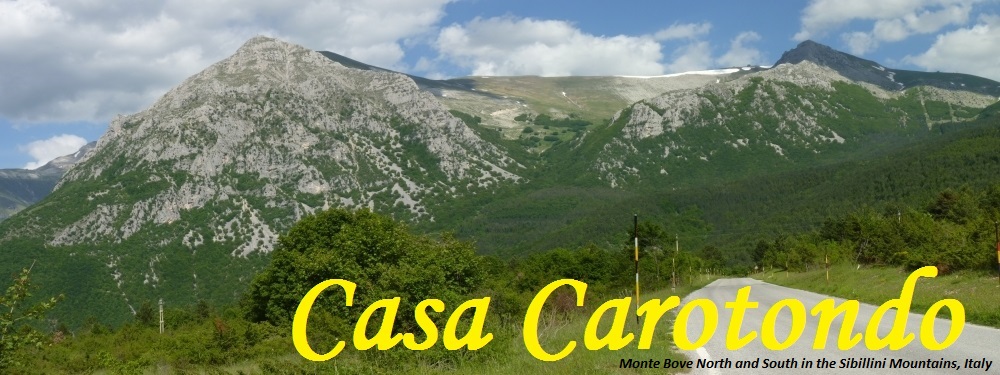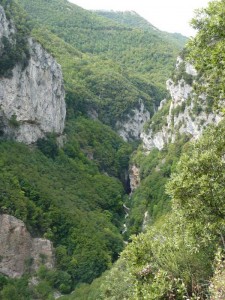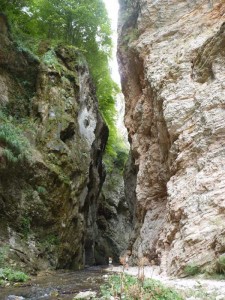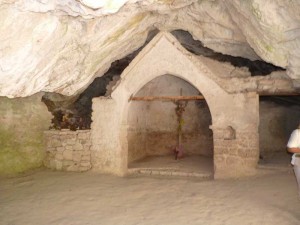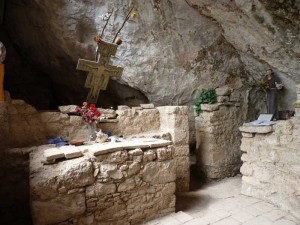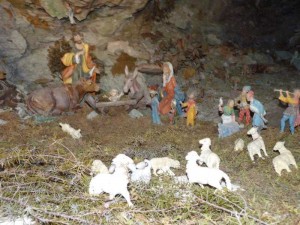There are two relatively easy walks that take in the Grotta dei Frati. You can park at the small hamlet of Monastero walking down the hillside to the river Fiastrone and then a small way up the other side. Most people doing this walk would also visit the gorge of Fiastra by walking along the river bed. Wellies are the best footwear for the gorge walk. Even in late summer you will get wet, cold feet! The river bed is full of small stones so bare feet are definitely not recommended. The other route to the Grotta dei Frati is via the dam wall of the Lago di Fiastra. In order to reach the caves you pass the Lame Rosso – also worth a visit. These are weathered rocks – Le Marche’s very own mini version of Bryce Canyon in the US. Both of these routes are signposted, they are cool and covered by trees so ideal for the summer and they are not particularly long or difficult. If you are feeling lazy you can drive via the town of Cessapalombo to a nearby parking area and then walk a short way.
The Fiastra Valley actually contains a large number of caves, many of which were probably occupied by hermit monks at one time or another. The difference with the Grotta dei Frati is that there is actually documentary evidence that it was inhabited and excavations have confirmed this. The cave is situated on the side of Monte Fiegno high above the river. The biggest cave has been inhabited since at least 1234 starting with Benedictine monks. The little Church in the cave was then dedicated to St. Egidio, a hermit. A spur of rock that stands opposite the cave, on which it is said he sat to pray and meditate, is named after him. The cave was eventually inhabited by the “Clareni” monks, dissidents of the Franciscan order and followers of Angelo Clareno (died 1334).They were widely regarded as heretics and were persecuted as such by the mainstream Church. They re-named the Church “Santa Maria Maddalena de Specu”.
The monks did not just live in the cave, they probably constructed three floors for, at its height, about 16 monks to live in. It is thought they even grew vegetables, vines and maintained fruit trees. It is assumed that the first thing the monks did was to build a large water tank to have abundant resources to mix with lime and clay to make the “cement” for the stones used in the construction of the rest of the cave. The tank was constructed in such a way that every possible drop of water could be saved. The tank is still visible today. It is then assumed that the monks constructed the outer walls of their monastery. The wall remaining that surrounds the west of the hermitage towards the cave called the “Partigiani” is very thick . The ground was leveled and stabilized. On this they built three floors. The ground floor remains partially buried under rubble but you can imagine that this was crossed by a corridor that led into the various rooms or cells. The biggest room, which was probably the dining room, can be accessed by going behind the alter. The first floor is accessed via a flight of stairs still intact that rise to the right of the entrance to the cave. Once at the top, turning your gaze to the right and against the rock, you can see the holes in the support beams that made up the floor of the attic as well as those of the roof. A cutting was made in the rock to direct water away from the roof. The hermitage must have been a reasonable size considering the supporting wall was over a hundred feet and the wall from the entrance of the cave to the last ruins of the monastery are about 25m.
In 1587 there were 7 brothers living there, one less than at the nearby Monastery of San Liberato. Several decades earlier Capuchin monks had tried to take over the cave with the support of the Duchess Caterina Cibo, wife of Giovanni Maria Da Varano Duke of Camerino and nephew of Clemente VII. Despite this weighty support they were unable to stake their claim. The petition to the Pope is however interesting in that it provides documentary evidence that Clareni monks were living in the cave. The petition states that the monks were allowed to live in the cave if they lead the life of hermits according to the Rule of St. Francis and subjected themselves to the jurisdiction of the Bishop of Camerino. The document, however, claims that the monks were leading dissolute lives causing scandal among the local population. Furthermore they were working on another cave monastery further down the valley with the aim of relocating. The Duchess wanted the Clareni monks replaced with some of the same order of St. Francis who would observe his Rule and lead a hermit’s life in poverty. The monks were labeled as sordid malcontents who wore sheepskins or other dirty rags and who occasionally descended from the mountains to the villages to sing, beg and curse the rich.
In 1652, a time when small religious communities were being suppressed the monastery of the Cave was affiliated to that of Colfano. They provided for religious services on Holy Days for the local shepherds and charcoal workers. Slowly the community died out and the cave was taken over by nature. It is thought that either the spring serving the community dried up making the place uninhabitable or possibly it was diverted in an attempt to force the monks out of the cave.
Recently it was thanks to one of the monks of the Minori di Colfano that the debris inside the cave was removed and it has been returned to its original state with the little church, the water tank and the altar visible. Padre Natale Sartini was driven by the desire to return to this to a place of prayer, if only for a few days of the year and relive the religious services of the upper Colfano of 1652. On April 9th. 1989 Padre Natale was able to place a statue of St. Francis in the cave along with a depiction of the Nativity.
On the side of the large cave are two smaller ones. One called the Grotta del Lavatoio (literally – cave of the laundry) is of a modest size and has on the floor opposite the entrance a supporting wall and a small basin similar to a wash basin or a font used by the community. The other cave, known as the Grotta dei Partigiani because it was used by resistance fighters in the last war, is accessed via a narrow path. It is a large cave but not very high and houses a small Madonna.
The information for this blog is taken from a document written by Gian Carlo Giubileo you can read the original Italian at http://www.turismo.cessapalombo.sinp.net/index2.htm
